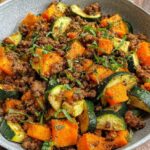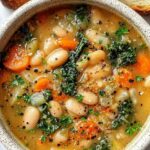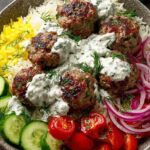Baked Brie with Roasted Plums and Thyme for an Elegant Appetizer
Imagine pulling a golden, bubbling dish from your oven that fills your kitchen with an irresistible aroma. This stunning Baked Brie with Roasted Plums and Thyme creates exactly that magical moment. Furthermore, it transforms simple ingredients into a show-stopping centerpiece for any gathering. The contrast of warm, melted cheese and sweet-tart fruit will captivate your guests from the very first bite.
Creating this elegant appetizer requires minimal effort for maximum impact. In fact, you only need a handful of ingredients and about half an hour. The process involves roasting plums with honey and thyme until they caramelize beautifully. Meanwhile, the brie bakes until its center becomes gloriously gooey. Finally, you combine these elements into a harmonious dish that tastes as incredible as it looks.
This recipe for Baked Brie with Roasted Plums and Thyme works perfectly for both casual get-togethers and formal occasions. Its sophisticated flavor profile belies the straightforward preparation. Consequently, you can focus on your guests rather than complicated kitchen tasks. The result consistently earns compliments and requests for the recipe.
Quick Recipe Highlights
- Flavor Profile: Sweet honey and caramelized plums balance the rich, creamy brie. Earthy thyme and a hint of black pepper add sophisticated depth. Every bite delivers a perfect harmony of sweet, savory, and tangy notes.
- Texture: The oozing, velvety brie contrasts with the tender roasted plum slices. A slight crust forms on the baked cheese wheel. Additionally, the fruit develops a lovely jammy consistency that spreads beautifully.
- Aroma: Warm, nutty cheese scent mingles with sweet stone fruit notes. Fresh thyme releases its herbal fragrance during roasting. The honey caramelizes, creating a sweet, inviting smell that permeates your kitchen.
- Visual Appeal: The deep purple plum slices arranged over golden brie create a stunning color contrast. Bubbling honey and thyme sprigs add decorative elements. This presentation looks professionally crafted yet achieves effortlessly.
- Skill Level Needed: Beginner cooks can master this recipe with ease. Basic knife skills for slicing fruit suffice. Moreover, the roasting and baking processes require simple monitoring rather than advanced techniques.
- Special Equipment: A baking sheet and small oven-safe dish or parchment paper work perfectly. You need no specialized tools. Consequently, this recipe fits any kitchen setup.
Recipe Overview
- Difficulty Level: This recipe ranks as easy because it involves straightforward preparation steps. You simply slice fruit, arrange ingredients, and bake. No technical skills or previous experience with baked brie recipes required.
- Category: This dish fits perfectly into the appetizer category for entertaining. It also works as a luxurious snack or dessert option. The versatility makes it suitable for various meal contexts.
- Cuisine: While brie originates from French cuisine, this preparation incorporates modern American entertaining styles. The combination with roasted fruit reflects contemporary culinary trends. Ultimately, it creates a fusion approach that appeals to diverse palates.
- Cost: Using one wheel of brie and a few plums keeps ingredients affordable. Honey and thyme are pantry staples that minimize additional expense. Therefore, this impressive dish fits most entertainment budgets beautifully.
- Season: Late summer through early fall offers perfect plum season for this recipe. However, you can adapt it year-round with other fruits. Consequently, it remains a versatile option for any season.
- Occasion: This elegant appetizer shines during holiday parties, book clubs, and dinner parties. It also elevates casual weeknight meals. The adaptability makes it appropriate for numerous social situations.
Why You’ll Love This Recipe
The taste experience of this Baked Brie with Roasted Plums and Thyme will genuinely delight your palate. Firstly, the warm, creamy cheese provides a rich, luxurious base. Meanwhile, the roasted plums contribute natural sweetness with subtle tartness. The thyme adds an herbal note that cuts through the richness perfectly. Additionally, the honey caramelizes during baking, creating complex flavor dimensions. Every component complements the others harmoniously.
Convenience represents another significant advantage of this recipe. You can prepare the entire dish in about thirty-five minutes with minimal active effort. Furthermore, the ingredient list remains short and accessible. Most components are pantry staples or easily found at any grocery store. The simple preparation means you can assemble it quickly when guests arrive unexpectedly. Consequently, it becomes your go-to impressive appetizer solution.
Nutritional considerations make this dish a smarter choice than many entertainment options. Plums provide dietary fiber, vitamins, and antioxidants. Meanwhile, brie offers protein and calcium. Using honey instead of refined sugar adds natural sweetness. You can control the quality of ingredients based on your preferences. Therefore, you serve a treat that balances indulgence with some nutritional benefits.
Social and entertaining value makes this recipe particularly special. The dramatic presentation creates an immediate centerpiece for any gathering. Guests gather around as you slice into the molten cheese. Moreover, the communal aspect of sharing from one dish encourages conversation and connection. It serves as both food and entertainment, breaking the ice at any party.
Cost-effectiveness and accessibility complete the appeal of this wonderful dish. Compared to store-bought appetizers, homemade versions save significantly. A single wheel of brie and a few plums serve six people generously. Additionally, you likely have honey and thyme in your kitchen already. The impressive result belies the modest investment required.
Historical Background and Cultural Significance
Brie cheese boasts a rich history dating back to French royalty. Historical records indicate Charlemagne declared it his favorite cheese in 774 AD. Furthermore, French kings traditionally received wheels of brie as tribute. The cheese’s origins trace specifically to the Brie region northeast of Paris. Monks in medieval monasteries reportedly perfected the production techniques. Consequently, brie earned the nickname “The King of Cheeses” throughout Europe.
Cultural significance of baked brie extends beyond its French origins. American entertaining culture embraced baked brie during the 1980s dinner party era. Meanwhile, the combination with fruit represents a natural culinary evolution. Various cultures pair cheese with fruit, from Italian giardiniera to British ploughman’s lunch. This recipe modernizes that traditional pairing with specific technique and presentation.
The evolution of this specific recipe reflects contemporary entertaining trends. Home cooks increasingly seek impressive yet manageable dishes for gatherings. Additionally, the preference for sweet and savory combinations has grown substantially. Roasting fruit to enhance its natural sugars represents a modern cooking technique. These elements converge in this particular preparation of Baked Brie with Roasted Plums and Thyme.
Regional variations demonstrate the recipe’s adaptability. Different areas substitute local fruits based on seasonal availability. Some versions incorporate nuts or different herbs for regional flair. The basic concept remains constant while ingredients shift accordingly. This flexibility contributes to the recipe’s enduring popularity across diverse culinary traditions.
Ingredient Deep Dive
Brie cheese forms the foundation of this magnificent appetizer. This soft-ripened cheese originated in France and features a edible white rind. The interior becomes beautifully molten when heated while the rind contains the flow. Nutritionally, brie provides protein, calcium, and vitamin B12. Select a wheel that feels slightly springy to the touch without excessive softness. Store brie in the refrigerator’s cheese drawer until ready to use. If unavailable, camembert makes an excellent substitution with similar melting properties.
Plums contribute the sweet-tart element that balances the rich cheese. These stone fruits have centuries of cultivation history across Asia, Europe, and America. They offer dietary fiber, vitamin C, and antioxidant compounds. Choose plums that yield slightly to gentle pressure with vibrant skin color. Store ripe plums in the refrigerator to maintain freshness. When plums are out of season, peaches, nectarines, or apricots work wonderfully as alternatives.
Fresh thyme provides the herbal note that elevates this dish beyond simple cheese and fruit. This Mediterranean herb has culinary and medicinal history dating to ancient Egypt. Thyme contains thymol, a compound with antioxidant properties. Select bunches with vibrant green leaves without excessive dryness. Store thyme in the refrigerator wrapped lightly in damp paper towel. Rosemary or sage can substitute if necessary, though they impart stronger flavors.
Honey serves as both sweetener and glaze in this preparation. Humans have harvested honey for over 8,000 years, making it one of our oldest sweeteners. It contains trace enzymes, antioxidants, and minerals. Choose locally sourced honey when possible for optimal flavor. Store honey at room temperature in a sealed container. Maple syrup or agave nectar can replace honey for different flavor profiles or dietary needs.
Common Mistakes to Avoid
- Overbaking the brie causes excessive oil separation and tough texture. The cheese should feel soft when pressed but maintain its wheel shape. Remove it from the oven when the center feels very soft to the touch.
- Using overripe or underripe plums affects the final flavor balance. Overripe fruit becomes mushy when roasted while underripe fruit lacks sweetness. Select plums that yield slightly to gentle pressure for ideal results.
- Skipping the resting period after baking creates messy serving difficulties. The cheese needs five minutes to set slightly before cutting. This brief wait ensures beautiful presentation rather than liquid chaos.
- Overcrowding the baking sheet prevents proper caramelization of the plums. Arrange them in a single layer with space between slices. This spacing allows moisture to evaporate and caramelization to occur.
- Using dried thyme instead of fresh diminishes the aromatic quality. Fresh herbs provide brighter flavor and better texture in this preparation. The delicate leaves withstand roasting better than dried varieties.
- Neglecting to score the brie rind limits flavor penetration. Make shallow cuts across the top before baking. This technique allows the honey and fruit juices to flavor the cheese interior.
- Choosing the wrong serving vessel creates difficulties with cheese retrieval. Use an oven-safe dish slightly larger than the brie wheel. This provides containment while allowing easy access for spreading.
- Serving with inappropriate accompaniments overwhelms the delicate balance. Avoid strongly flavored crackers that mask the subtle flavors. Instead, select neutral crackers or bread that complement without competing.
Essential Techniques
Roasting fruit requires understanding how heat transforms its natural sugars. This process caramelizes the sugars while concentrating the flavor. Arrange plum slices in a single layer on your baking sheet. Furthermore, leave space between pieces to allow steam evaporation. The plums should become tender and slightly browned at the edges. Watch for this visual cue to determine perfect doneness.
Preparing brie for baking involves several important steps. First, score the top rind in a crosshatch pattern without cutting deeply. This allows flavors to penetrate while maintaining structural integrity. Secondly, place the wheel on an oven-safe serving dish or parchment-lined baking sheet. The cheese bakes until the center feels soft when gently pressed. Importantly, the rind should remain intact to contain the molten interior.
Timing coordination between components ensures optimal results. Begin roasting the plums first since they require slightly longer cooking. Add the brie to the oven during the final fifteen minutes. This synchronization means both elements finish simultaneously at perfect temperature. Consequently, you serve everything at its peak texture and flavor.
Pro Tips for Perfect Baked Brie with Roasted Plums and Thyme
Bring brie to room temperature before baking for more even melting. This simple step prevents a cold center while the exterior overcooks. Approximately thirty minutes on the counter suffices for proper temperature adjustment.
Select slightly firm plums rather than extremely ripe ones for better roasting results. They maintain their shape better during cooking while still softening beautifully. The texture contrast with the creamy cheese becomes more pronounced.
Add a pinch of flaky sea salt before serving to enhance all flavors. The salt crystals amplify the sweetness of fruit and richness of cheese. This professional touch elevates the entire dish significantly.
Arrange thyme sprigs artistically over the plums before roasting. The leaves will crisp while stems infuse subtle flavor. Furthermore, this creates an attractive presentation directly from the oven.
Use a sharp, thin-bladed knife for clean plum slices. This ensures even cooking and elegant appearance. Additionally, a good knife makes the preparation process safer and more efficient.
Consider toasting your serving crackers or bread for added texture contrast. The crispness complements the soft cheese and fruit wonderfully. This extra step requires minimal effort for maximum impact.
Variations and Adaptations
Regional variations allow customization based on local ingredients. Mediterranean versions might incorporate figs and rosemary instead of plums and thyme. Meanwhile, American adaptations often use apples or pears during autumn months. Tropical interpretations could feature mango or pineapple with coconut notes. These alternatives maintain the core concept while reflecting regional flavors.
Seasonal adaptations ensure year-round enjoyment of this versatile recipe. Spring versions might utilize rhubarb and strawberries with mint. Summer adaptations could feature peaches or nectarines with basil. Autumn preparations often incorporate pears or apples with sage. Winter variations might use cranberries or citrus with rosemary. Each season offers unique fruit and herb combinations.
Dietary modifications accommodate various eating preferences and restrictions. Vegan versions utilize plant-based cheese alternatives and maple syrup. Gluten-free needs are naturally met with appropriate cracker selections. Lower-carb adaptations reduce honey and increase herbs for flavor. Dairy-free options employ sophisticated nut-based cheeses with similar melting properties.
Flavor variations introduce exciting new dimensions to the basic recipe. Adding orange zest to the honey provides citrus brightness. Incorporating crushed nuts offers textural contrast. A drizzle of balsamic reduction adds sophisticated acidity. Spices like cinnamon or cardamom create warmth and complexity. Each variation maintains the dish’s essential character while offering new experiences.
Serving and Presentation Guide
Plating techniques maximize visual impact for this beautiful appetizer. Transfer the baked brie carefully to a serving board or platter. Arrange the roasted plum slices artistically around and over the cheese wheel. Drizzle any remaining honey-thyme syrup from the baking sheet over everything. Finally, garnish with fresh thyme sprigs for color and aroma.
Garnishing ideas enhance both appearance and flavor. Fresh thyme sprigs provide green contrast against the golden cheese and purple fruit. Edible flowers create stunning visual appeal for special occasions. Meanwhile, chopped toasted nuts add texture and sophistication. A light dusting of powdered thyme or black pepper completes the presentation.
Traditional accompaniments complement without overwhelming the delicate flavors. Plain water crackers or baguette slices work perfectly. Additionally, crisp apple slices provide refreshing contrast. Toasted walnut bread offers nutty flavor harmony. Simple breadsticks allow easy dipping into the molten cheese.
Modern serving suggestions include creative approaches for contemporary entertaining. Individual ramekins with smaller brie portions create personalized presentations. Furthermore, deconstructed versions arrange components separately for guest customization. Mini phyllo cups filled with the mixture make elegant passed appetizers. Each approach maintains the essential flavor combination while updating the presentation style.
Wine and Beverage Pairing
Wine pairings should complement both the rich cheese and sweet fruit elements. A slightly sweet Riesling or Gewürztraminer balances the dish beautifully. Meanwhile, sparkling wines like Prosecco or Cava cut through the richness effectively. Light-bodied reds such as Pinot Noir work surprisingly well too. Ultimately, the beverage should refresh the palate between creamy, sweet bites.
Non-alcoholic alternatives provide sophisticated options for all guests. Sparkling apple cider mirrors the fruit notes in the dish. Herbal teas like chamomile or mint complement the thyme elements. Additionally, ginger beer offers spicy contrast to the rich cheese. Lemon-infused sparkling water cleanses the palate refreshingly between bites.
Coffee and tea pairings work wonderfully when serving this as dessert. Lightly roasted coffee with low acidity complements without overwhelming. Earl Grey tea’s bergamot notes harmonize with the thyme. Chai tea’s spices echo warm baking flavors. Herbal citrus teas provide bright contrast to the rich components.
Storage and Shelf Life
Storage methods depend on whether components remain combined or separate. Refrigerate any leftovers in airtight containers promptly. Importantly, store the cheese and fruit mixture separately from crackers or bread. This prevents sogginess and maintains optimal textures until serving.
Temperature requirements ensure food safety and quality preservation. Refrigerate at 40°F or below within two hours of serving. Furthermore, avoid freezing the complete assembled dish. The texture of previously frozen brie becomes grainy upon thawing.
Container recommendations include glass or BPA-free plastic with tight seals. Separate smaller portions into individual containers for easy reheating. Additionally, place parchment between layers if stacking multiple portions. This prevents sticking and maintains presentation quality.
Make Ahead Strategies
Prep timeline optimization makes entertaining stress-free. You can slice plums and prepare the honey-thyme mixture one day ahead. Store these components separately in the refrigerator until ready to use. The brie itself should remain whole and refrigerated until baking time.
Storage between steps maintains ingredient quality and food safety. Keep prepared plum slices in an airtight container with a squeeze of lemon juice. This prevents browning while enhancing flavor. Meanwhile, store the honey-thyme mixture at room temperature to maintain consistency.
Quality impact assessment helps determine which steps work best in advance. The plums actually benefit from marinating in the honey-thyme mixture. However, scoring the brie should happen immediately before baking. This prevents the rind from drying out excessively.
Scaling Instructions
Halving the recipe works perfectly for smaller gatherings. Use a smaller brie wheel or cut a standard wheel in half. Reduce plum quantity to two medium fruits. Adjust other ingredients proportionally while monitoring baking time carefully. Smaller quantities may require slightly reduced cooking time.
Doubling or tripling accommodates larger parties efficiently. Use multiple baking sheets to avoid overcrowding the plum slices. Arrange brie wheels with space between for proper heat circulation. Additionally, rotate baking sheets halfway through cooking for even results. Consider staggering baking times if oven space is limited.
Equipment adjustments ensure success when changing quantities. Larger baking sheets or multiple sheets become necessary. Additionally, ensure your oven racks accommodate the increased volume. You might need to bake in batches for very large quantities.
Nutritional Deep Dive
Macro breakdown reveals a balanced profile for an appetizer. The dish provides protein from cheese, carbohydrates from fruit and honey, and moderate fat. Brie contributes casein protein that digests slowly. Meanwhile, plums offer natural sugars with fiber that moderates absorption.
Micronutrient analysis shows valuable vitamin and mineral content. Plums provide vitamin C, vitamin K, and potassium. Brie contributes calcium, phosphorus, and vitamin B12. Additionally, thyme offers iron and manganese in small amounts.
Health benefits include bone support from calcium and antioxidant protection from plums. The combination provides sustained energy release rather than sugar spikes. Furthermore, the protein promotes satiety, potentially preventing overeating.
Dietary Adaptations
Gluten-free adaptation requires only careful cracker selection. The core recipe contains no gluten-containing ingredients. Simply serve with certified gluten-free crackers or bread. Additionally, ensure all packaged ingredients carry gluten-free certification if needed.
Dairy-free modification utilizes plant-based cheese alternatives. Several brands now offer meltable vegan brie-style products. The roasting process works identically with plant-based cheeses. Furthermore, the fruit and herb components remain unchanged.
Vegan adaptation combines dairy-free cheese with maple syrup instead of honey. Select a high-quality vegan brie that melts properly. Use agave or maple syrup as the sweetener. All other components naturally align with vegan dietary patterns.
Troubleshooting Guide
Texture issues commonly involve cheese that becomes oily or fruit that turns mushy. Overbaking causes both problems, so monitor timing carefully. If brie releases excessive oil, blot gently with paper towels before serving. For overly soft plums, briefly roast at higher temperature to evaporate excess moisture.
Flavor balance problems might include excessive sweetness or insufficient seasoning. If the dish tastes too sweet, add black pepper or thyme to counterbalance. When flavors seem flat, a pinch of salt typically enhances all elements. Lemon juice can brighten if the fruit lacks natural acidity.
Temperature problems usually involve cheese that cools too quickly before serving. Prepare accompaniments in advance so everything is ready when the dish emerges from oven. Use a warmed serving platter to maintain temperature longer. If necessary, briefly return the assembled dish to the oven for one minute before serving.
Recipe Success Stories
Community feedback consistently highlights how this recipe impresses guests effortlessly. Many home cooks report it becoming their signature party dish. Furthermore, numerous readers have adapted it successfully for various dietary needs. The basic method proves remarkably forgiving while delivering spectacular results.
Variation successes demonstrate the recipe’s wonderful flexibility. One reader substituted peaches and lavender during summer with brilliant results. Another used pears and rosemary for a winter holiday party. These adaptations maintain the core technique while incorporating seasonal ingredients beautifully.
Photography tips from successful makers emphasize natural lighting and quick shooting. The cheese continues to set after removal from oven, so work efficiently. Capture the moment when someone breaks into the molten center. Additionally, overhead shots showcase the beautiful plum arrangement effectively.
Frequently Asked Questions
Can I make this recipe with other fruits? Absolutely, this recipe adapts wonderfully to various fruits. Pears, apples, peaches, and figs all work beautifully. The key is selecting fruits that roast well and provide pleasant texture contrast. Adjust roasting time based on fruit density and moisture content.
How do I know when the brie is perfectly baked? The brie should feel very soft to the touch when gently pressed. The rind may develop slight golden spots, and the center should visibly bulge. Importantly, the wheel should maintain its shape rather than collapsing completely.
Can I prepare any components in advance? You can slice the plums and prepare the honey-thyme mixture ahead. Store them separately in the refrigerator until ready to use. However, assemble and bake the complete dish just before serving for optimal texture.
What if I don’t have fresh thyme? While fresh thyme provides optimal flavor, dried thyme can substitute in a pinch. Use one-third the amount of dried thyme since dried herbs are more concentrated. Alternatively, rosemary or sage offer different but complementary herbal notes.
How long do leftovers keep? Refrigerate leftovers promptly in airtight containers for up to three days. Reheat gently in the oven rather than microwave for best texture. The plums make a wonderful addition to oatmeal or yogurt even after separation.
Can I freeze this dish? Freezing is not recommended for the complete assembled dish. Previously frozen brie develops grainy texture upon thawing. However, you can freeze the roasted plum component separately for up to three months.
What’s the best way to serve this to a crowd? For larger groups, consider using multiple smaller brie wheels rather than one large one. This creates multiple serving points and ensures everyone gets perfectly melted cheese. Arrange them on a large board with separate piles of roasted plums.
My brie leaked everywhere during baking. What happened? This typically occurs if the rind gets punctured before baking. Ensure you score only the top surface lightly without cutting through the sides. Using a baking dish with slight edges contains any minor leakage.
Can I use frozen plums? Frozen plums can work but will release more liquid during roasting. Thaw them completely and pat dry before using. Expect slightly softer texture and adjust roasting time accordingly for proper caramelization.
What crackers work best with this dish? Simple, neutral crackers complement without overwhelming the delicate flavors. Water crackers, plain baguette slices, or lightly salted crackers work perfectly. Avoid strongly flavored or heavily seasoned options that compete with the dish.
Additional Resources
Related recipes that complement this appetizer include various cheese board additions. Marinated olives, spiced nuts, and homemade chutneys all pair beautifully. Furthermore, simple salad recipes with vinaigrette dressings provide refreshing contrast. These additions create a complete entertaining menu around your spectacular Baked Brie with Roasted Plums and Thyme.
Technique guides for working with cheese enhance your culinary skills. Understanding cheese melting properties helps with numerous recipes. Additionally, fruit roasting techniques apply to desserts, side dishes, and other appetizers. These fundamental skills elevate your overall cooking capabilities beyond this single recipe.
Ingredient information resources help you select optimal components. Cheese buying guides explain differences between brie styles and quality indicators. Meanwhile, seasonal fruit charts show availability timelines for various plum varieties. This knowledge ensures you always select the finest ingredients for your creations.
{“success”:true,”message”:”Recipe created successfully”,”post_id”:6684,”tasty_recipe_id”:6684,”shortcode”:” Print
Baked Brie with Roasted Plums and Thyme
5 Stars 4 Stars 3 Stars 2 Stars 1 Star
No reviews
- Author: Chef Billy
Description
A warm, gooey baked brie topped with sweet roasted plums and fragrant thyme, perfect for an elegant appetizer or dessert.
Ingredients
For the Crust:
- 1 wheel of brie (8 oz)
- 2 ripe plums, pitted and sliced
- 2 tbsp honey
- 1 tbsp fresh thyme leaves
- 1 tbsp olive oil
- 1/4 tsp black pepper
- Crackers or baguette slices for serving
Instructions
1. Prepare the Crust:
- Preheat oven to 350°F (175°C). Place brie wheel in a small baking dish.
- In a bowl, toss plum slices with olive oil, honey, thyme, and black pepper.
- Arrange plum slices around and on top of the brie.
- Bake for 20-25 minutes, until brie is soft and plums are tender.
- Let cool for 5 minutes before serving with crackers or baguette slices.
Notes
You can customize the seasonings to taste.
I’m Billy, a classically trained culinary school graduate from The Culinary Institute of America with over 12 years in the restaurant industry and over 19 years of cooking experience.







